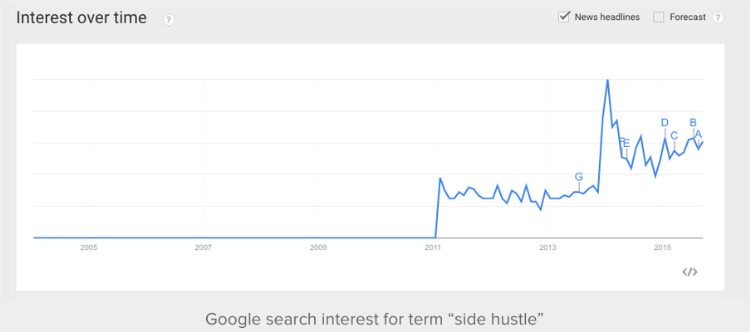In 2006, a man named Bill Peters defined the word “side hustle” on UrbanDictionary.com:

In that year, Google Trends registered exactly 0 searches for the term and it remained that way through 2011. Since then, the number of searches has grown by 6,000% and the definition has broadened to encapsulate a lot more than just weekend gigs and life coaching.
Over the past two years, our team at Purpose Generation has had hundreds of conversations with peers about what makes them tick and how they spend their time. Given that we spend the majority of our waking hours dedicated to working, our career is inherently a big part of these conversations. In fact, one of the patterns that originally motivated us to start Purpose Generation was seeing our friends leave their comfortable, 6-figure jobs at banks, consulting firms, and Fortune 500’s, in favor of higher risk, lower-paying opportunities at startups.
The promise of increased flexibility and purpose are two of the main drivers behind this exodus from Corporate America.
With almost 60% of Millennials willing to take a 15% pay cut to work for a company whose values align with their own; 45% of Millennials choosing workplace flexibility over pay (Net Impact); and 78% of Millennials reporting that enjoying their work is more important than their salary (Clark University), companies can no longer afford to ignore what Fast Company and Forbes are referring to as “The Future of Work”.
This not to say prior generations weren’t just as passionate or engaged. Of course they were. The difference is that Corporate America simply wasn’t set up to support them, prioritizing face-time and hierarchy over productivity and output.
Shifting priorities among younger employees has led to an uptick in the number of people pursuing “portfolio careers,” a term that was first coined by Irish author and organizational management specialist, Charles Handy.
Handy predicted that individuals would increasingly leverage their unique portfolios of skills, abilities, and achievements to gain temporary employment opportunities in a variety of organizations simultaneously. It turns out, Handy was quite the visionary. According to a recent report on Freelancing in America, 34% of the U.S. workforce is currently considered contingent, temporary, diversified or freelance and this number is expected to grow to 40% by 2020.
While freelancing is becoming increasingly accepted as a worthwhile career path, however, there is still a certain stigma attached to these alternative types of employment. As a result, people juggling multiple jobs may only share part of the truth when asked what they do, out of discomfort or embarrassment, when instead they should be lauded for it.
There are a variety of explanations for this tension, but one easily-addressable one is the fact that there is still no solid definition for these types of sideline activities. The Freelancing in America report introduces new definitions for the type of worker, such as “moonlighter” – a full time employee who also does additional freelance work on the side – but the report makes no mention of the type of work itself.
To continue reading this post from our partner Purpose Generation, click here. And if you’re interested in starting a side hustle of your own, check out TribeTalk, the easiest way to get rewarded for sharing your opinion with brands.










